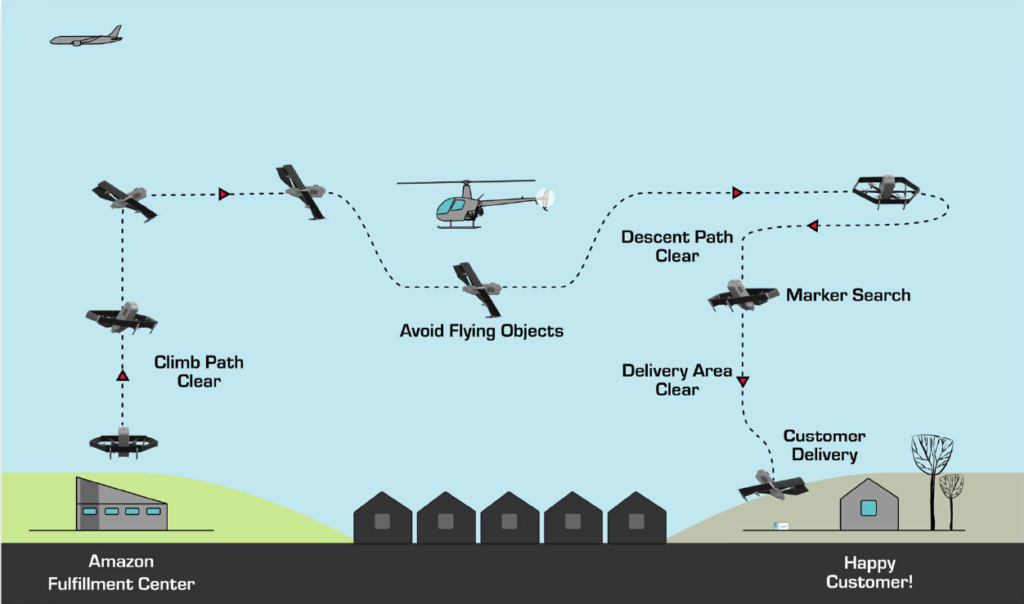As 2019 comes to a close, here is a look back at the top 10 most viewed stories published by Avionics International this year. The articles are ranked 1-10 based on an analytics tool used by our editorial team called Parsely that tracks readership article views with clicks, time on page and the digital channel or platform by which they accessed the article.

Amazon Prime Air’s general concept of operations, according to its FAA filing. (Amazon)
Amazon formally requested FAA approval to operate as a Part 135 unmanned air carrier to conduct commercial drone deliveries in the United States. The 29-page letter sent by Amazon also requests a number of waivers, including allowing the company to use aircraft that don’t have an airworthiness certificate.

Pilots and engineers from American Airlines and L3Harris recently completed flight tests evaluating the use of SafeRoute+ ADS-B In retrofit technology. Photo: L3Harris
American Airlines is in the final stages of obtaining certification on the use of automatic dependent surveillance broadcast (ADS-B) In, a cornerstone technology of the FAA’s ongoing NextGen airspace system modernization program, after completing recent ground and flight tests with a retrofitted system capable of enabling its use in U.S. airspace.

Predictive maintenance is still in its infancy for commercial airlines, but in the future will evolve into intelligent maintenance for large-fleet commercial operators. Airlines based in the U.S., Europe and Asia have been quietly adopting AI tools in the form of intelligent agents for data modeling and simulation to the use of cognitive computing. The use of AI within airline maintenance strategies is evolving into an advanced and expanded use of predictive data analytics.

Airbus’ H160M demonstrator static display ambiance at the 2019 Paris Air Show. Photo: Airbus
During a briefing at one of its U.S.-based helicopter manufacturing facilities, Airbus Helicopters President Romain Trapp said that the company looks forward to the introduction of the H160M for military markets with first delivery expected by 2026. The commercial H160 is to receive certification by the end of the year, according to the company.

Etihad Airways Boeing 787-9. Photo: Boeing
Etihad Airways is deploying a new cloud-hosted electronic flight bag (EFB) weather forecasting application across 100 of its in-service aircraft fleet that will give the UAE national carrier’s pilots access to turbulence alerting, areas of icing and other information graphically depicted on tablet screens.

The European Aviation Safety Agency (EASA) issued a statement of clarification regarding its position on the Boeing 737 MAX’s return to service. Photo: EASA
On Sept. 27, the European Aviation Safety Agency (EASA) clarified statements it made that were published in an article by a publication called Flyers Rights about the process it is currently undergoing to investigate and review the certification and eventual return to service of the Boeing 737 MAX .

The CityAirbus demonstrator project is part of Airbus’ wide approach to urban air mobility and eVTOLs. Other major helicopter OEMs are less invested at the moment. (Airbus)
The development of electric and hybrid VTOL (eVTOL) aircraft around the world promises to usher in a new era of aerial mobility, changing the cost of access to vertical flight and potentially opening new markets.
Each of the four major helicopter manufacturers — Airbus, Bell, Leonardo and Sikorsky — are taking a different approach to confronting the market disruption eVTOL aircraft and urban air mobility will leave in their wake, with the former two companies investing heavily in public projects on the bleeding edge of the vehicle revolution while the latter two maintain more of a “wait-and-see” approach to the vehicles themselves.

Airbus aircraft models at the annual conference in Toulouse. Photo: Airbus
The A350 is now the flagship passenger jet for Airbus, after the manufacturer made a financial decision to end production on the A380, executives said during their annual conference in Toulouse, France. A380 deliveries will continue through 2021, and the four-engined jet will have maintenance and component support from Airbus for as long as airlines continue to fly it. However, with only 17 orders in the backlog remaining, the end of Airbus CEO Tom Enders’ reign will also mark the end of A380 production.

Amazon Prime Air Boeing 767. (Chad Slattery/Amazon)
Flight 3591 was a cargo plane that Atlas Air Worldwide was operating for Amazon’s transportation division. It left Miami for Houston at 11:30 a.m. eastern time and, after two hours, pilots contacted Houston controllers to begin their descent, according to Sumwalt. Controllers provided radar vectors to avoid some rain, then, six minutes later, cleared Flight 3591 to descend to 3,000 feet. At 12:39, with the aircraft traveling at 276 mph and having reached 6,000 feet, controllers lost radar and communications contact with the plane and it plunged into nearby Trinity Bay for unknown reasons. There was no distress call.

The Indonesian National Transportation Safety Committee (KNKT) final Lion Air JT610 737 MAX accident investigation report lists 89 findings explaining what factors caused the aircraft to crash and kill all 189 flight crew and passengers onboard during an October 29, 2018 flight. Photo: KNKT
Indonesia’s National Transportation Safety Committee (KNKT) published its final 322-page accident investigation report on the October 2018 Lion Air Boeing 737 MAX flight JT610 crash, finding that it was caused by a combination of an improperly aligned angle of attack (AOA) sensor, lack of pilot reporting and training as well as a breakdown in safety oversight of certification and design flaws shared between Boeing and the FAA within the aircraft’s maneuvering characteristics augmentation system (MCAS) system.